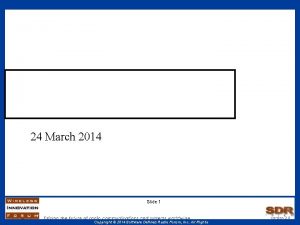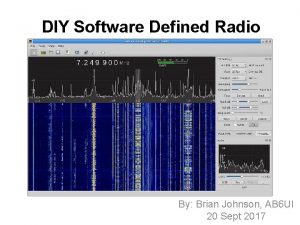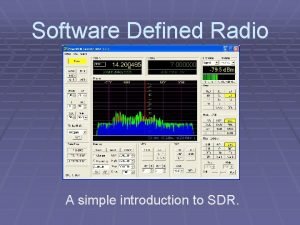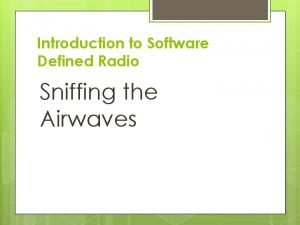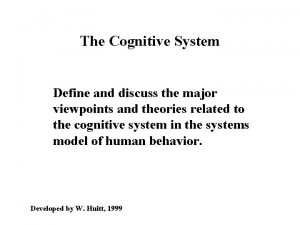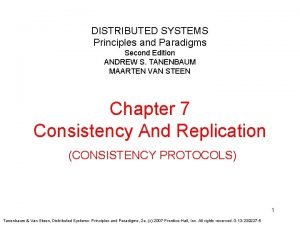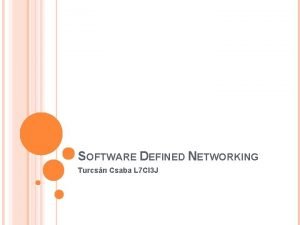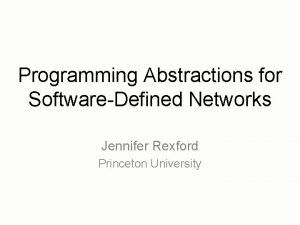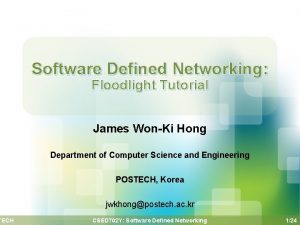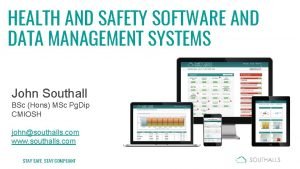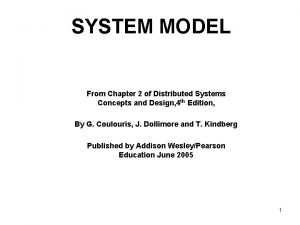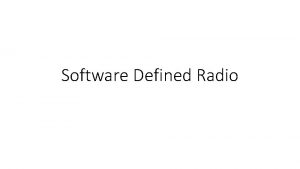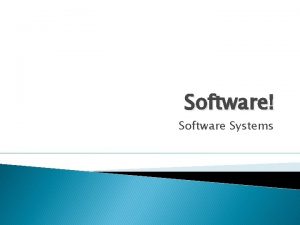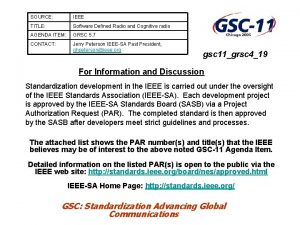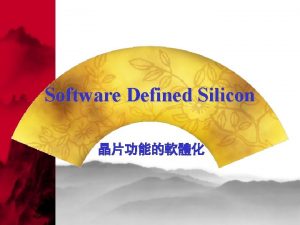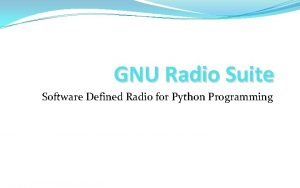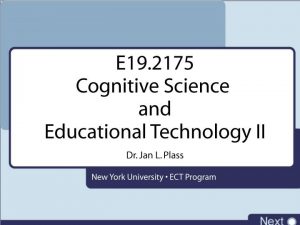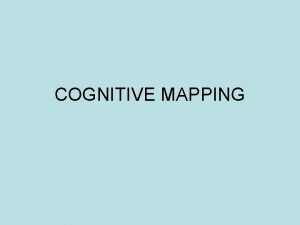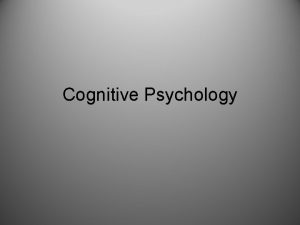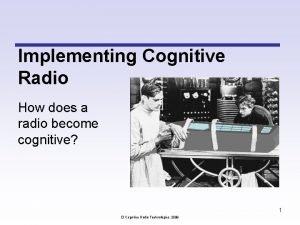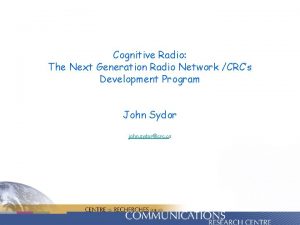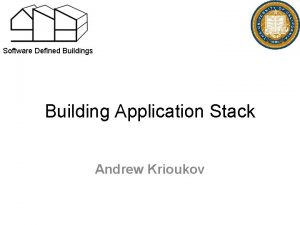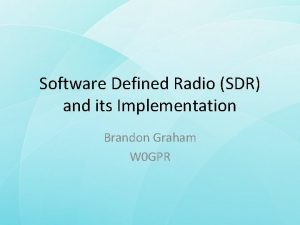Software Defined Radio and Cognitive Radio Systems Andrew






















- Slides: 22

Software Defined Radio and Cognitive Radio Systems Andrew CLEGG U. S. National Science Foundation aclegg@nsf. gov Third Summer School on Spectrum Management for Radio Astronomy Tokyo, Japan – June 3, 2010

Spectrum is a natural resource Spectrum is: • Finite. Today’s technology can only operate on certain frequencies; commercially viable frequencies are a scarce commodity. • Renewable. Airwaves used to broadcast any transmission can be reused after the broadcast is completed. • Technology dependent. Most natural resources can be harvested manually, albeit inefficiently. Spectrum is in the atmosphere and is usable because technology has been developed to exploit the properties of electromagnetic waves for sound, data and video transmission. • A national asset with international rules and regulations. For example, most domestic uses of spectrum are assigned bands of operation through the International Telecommunication Union, an agency of the United Nations; satellites for broadcasting are governed by international treaty. • Administered. To avoid interference from competing broadcast transmissions, frequency assignments are managed by recognized authorities.

Opportunistic Spectrum Use • • • Less than 5% of prime spectrum is used EVERYWHERE and ALL THE TIME these “white spaces” change with time and location! Need mechanisms that promote spectrum reuse, sharing, and ancillary secondary markets And that works for commercial, scientific, and government users Policy makers need to work proactively with technologists to enable more facile spectrum policies Source: Paul Kolodzy, Kolodzy Consulting (kolodzy. com)

Regulatory Activity REPORT ITU-R SM. 2152 (2009) “Definitions of Software Defined Radio (SDR) and Cognitive Radio System (CRS)” REPORT ITU-R M. 2117 (2007) “Software defined radio in the land mobile, amateur and amateur satellite services”

Technology Response to the Spectrum Quandary • SDR – Better spectral efficiencies – New waveforms • CRS – In some cases enabled by SDR – Spectrum Reuse possibilities – Awareness of under utilized spectrum • Dynamic Reconfiguration of radio and advantageous use of assignments

Ongoing SDR and CRS International Research • Government and Regional sponsored projects – Canada, China, Japan, EU • Standards Bodies – IEEE • Industry Groups • Academia Advances in software defined radio and cognitive radio systems may in time change the nature of spectrum allocation policies

Definition of Software Defined Radio (SDR) “Software-defined radio (SDR): A radio transmitter and/or receiver employing a technology that allows the RF operating parameters including, but not limited to, frequency range, modulation type, or output power to be set or altered by software, excluding changes to operating parameters which occur during the normal preinstalled and predetermined operation of a radio according to a system specification or standard. ”

SDR • The progression of hardwired functions to software running on processors is the natural evolution of digital applications – Audio functions migrated from DSPs to CPU – Modems migrated to “soft” modems – Correlators migrating from delay cables to ASICs to CPUs and FPGAs • Typically when it happens is a function of cost/flexibility: as number of radio interfaces increases it will become more economical to switch

Architectures of SDR Architecture Based on Current-Generation Technology Notes to Figure 1: • DUC: Digital upconverter • CFR: Crest factor reduction • PA: Power amplifier DDC: Digital downconverter DPD: Digital predistortion LNA: Low noise amplifier

Definition of Cognitive Radio System (CRS) “Cognitive radio system (CRS): A radio system employing technology that allows the system to obtain knowledge of its operational and geographical environment, established policies and its internal state; to dynamically and autonomously adjust its operational parameters and protocols according to its obtained knowledge in order to achieve predefined objectives; and to learn from the results obtained. ”

Methods of obtaining knowledge for CRS • Collecting information from components of CRS • Geo-location awareness • Spectrum sensing • Database access (central or distributed) • Listening to a wireless channel • Collaboration between different radio systems

Technical characteristics and capabilities of CRS • • The three technical features that characterize a CRS are: 1) the capability to obtain the knowledge of its radio operational and geographical environment, its internal state, and the established policies, and to monitor usage patterns and users’ needs, for instance, by sensing a spectrum, using a database, and receiving control and management information; 2) the capability to dynamically and autonomously adjust its operational parameters and protocols according to this knowledge in order to achieve predefined objectives, e. g. more efficient utilisation of spectrum; and 3) the capability to learn from the results of its actions in order to further improve its performance.

Background

Cognitive System Hierarchy Cost vs. Capability NIRVANA – STEALTH – NIB Autonomous Environment Aware May be able to identify location from peer network or LBS/GPS capabilities. Solicits operating rule set data from its network or internal database and operates in conformance with that information. Low cost – high volume Ubiquitous devices which MAY be AUTHORIZED to operate in many dimensions BUT may have internal system limitations. Could be a software controlled LEGACY Radio with minimal advanced technology. Follows orders from something like a PILOT CHANNEL! N Senses RF environment. Conforms with rule set(s) from internal database and operates in conformance with that information. Advanced capability to reconfigure RF operations $$$. $$ $ ¢ Higher capability Reads the PILOT CHANNEL data and may be able, if AUTHORIZED, to operate in many configurations or dimensions.

Policy-Defined, Cognitive Radios • Cognitive devices that – Are Aware • Of itself, its capabilities, its health, etc. • Of its environment • Of the effects of its actions – Can Reason • At different levels of abstraction using goals, policies, and models of its capabilities and environment • To determine behavior (sensing, evaluation, transmission)… – Can Adapt • To new business goals, policies, … – Can Learn • Better strategies, refined models • Are Able To Cooperate and Coordinate with peers – for mutual benefit – to achieve overall goal

Dynamic Spectrum • DS ALLOCATION – Opportunistic use of a resource pool of frequency assignments • Under license with liberalized use rules • DS ACCESS – Oppotunistic use of spectrum observed or otherwise identified as ‘available’ • Sensing • Pico Auctions

Dynamic Spectrum Access Etiquettes • • • Listen Before Talk. Least Interfered Channel. Fixed/Variable Frame Time Division. Transmit Power Control. Dynamic Frequency Selection. Location Dependent Spectrum Access. Time Dependent Spectrum Access. Mobility Dependent Spectrum Access. Permission (Positive/Negative Control) Dependent Spectrum Access • Duty Cycle Dependent Spectrum Access. • Protocol Dependent Spectrum Access.

WRC-12 Agenda Item 1. 19 • 1. 19 to consider regulatory measures and their relevance, in order to enable the introduction of softwaredefined radio and cognitive radio systems, based on the results of ITU‑R studies, in accordance with Resolution 956 (WRC‑ 07) – Resolution 956 (WRC-07): Regulatory measures and their relevance to enable the introduction of software-defined radio and cognitive radio systems.

SDR/CRS and Radio Astronomy

Challenges • Coherent non-blanking RFI excision algorithms often require knowledge of interfering waveform – SDR can change waveforms at will, possibly complicating automated excision efforts • Wholesale abandonment of allocations, allotments, and “command control” licensing could complicate predictions of the RFI environment in which we operate • Cognitive radios cannot autonomously sense the presence of a channel occupied by a passive service • The use of beacons or control channels to signal spectrum use would itself require more transmitters, possibly in otherwise “quiet” zones • Hacking of SDR and CRS could create spectrum chaos – security is needed

Opportunities • SDR and CRS are very likely the future of radio – we need to adapt • Radio astronomers have some experience with cognitive radio – Opportunistic out-of-band observing – Dynamic scheduling • Perhaps we can share some of our experiences with the CRS community • The adoption of SDR and CRS technologies is expected to be governed on a national and/or regional level – Be sure to contribute to relevant rulemakings, standards work, etc. • Perhaps wide scale adoption of CRS techniques might actually improve our ability to observe out-ofband

Resources • Wireless Innovation Forum (formerly the SDR Forum) – http: //www. wirelessinnovation. org • IEEE Standards Coordinating Committee 41 (Dynamic Spectrum Access Networks) – http: //grouper. ieee. org/groups/scc 41/index. html (main page) – http: //grouper. ieee. org/groups/scc 41/crinfo/ (Cognitive Radio Information Center)
 Software defined radio forum
Software defined radio forum Diy software defined radio
Diy software defined radio Softrock sdr
Softrock sdr Dsdplus download
Dsdplus download Sdr radio
Sdr radio Cognitive and non cognitive religious language
Cognitive and non cognitive religious language A collection of a well-defined objects
A collection of a well-defined objects Cognitive systems definition
Cognitive systems definition Distributed systems andrew s tanenbaum
Distributed systems andrew s tanenbaum Tanenbaum modern operating systems
Tanenbaum modern operating systems L7ci
L7ci Sdn introduction
Sdn introduction Abstractions for software defined networks
Abstractions for software defined networks Data plane control plane and management plane
Data plane control plane and management plane Mininet sdn tutorial
Mininet sdn tutorial Software defined networking tutorial
Software defined networking tutorial Software defined networking python
Software defined networking python Awin support
Awin support Decision support systems and intelligent systems
Decision support systems and intelligent systems Dss systems and software technologies pvt. ltd.
Dss systems and software technologies pvt. ltd. Software and systems integration facility
Software and systems integration facility Southall safety cloud 2
Southall safety cloud 2 Software and hardware service layers in distributed systems
Software and hardware service layers in distributed systems
